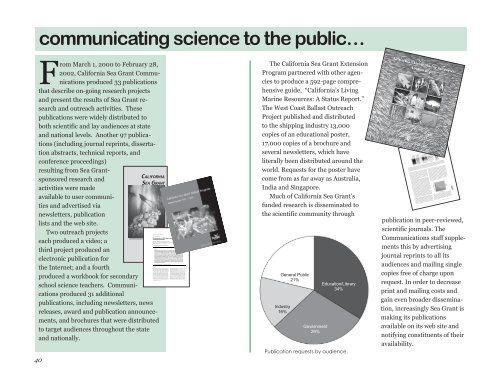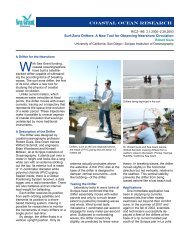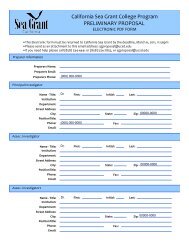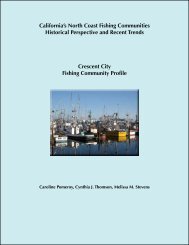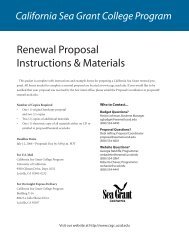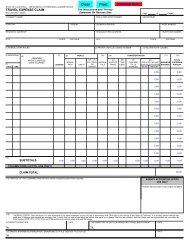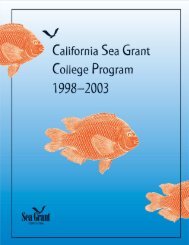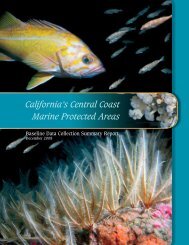2001â2002 - California Sea Grant - UC San Diego
2001â2002 - California Sea Grant - UC San Diego
2001â2002 - California Sea Grant - UC San Diego
Create successful ePaper yourself
Turn your PDF publications into a flip-book with our unique Google optimized e-Paper software.
of HSV8-lsc varies considerably depending on the growth conditions.<br />
Expre sion under the control of the rbcL promoter5 UTR<br />
resolved on SDSPAGE, and HSV8-lsc visualized by Western<br />
blo ting with anti Flag antibody. A shown in Fig. 6, a cumulation<br />
anti-flag antibody (Right). (B) Proteins fromE. coli and C. reinhardt i expre sing the Hsv8-lsc antibody were separated intosoluble and insoluble pe lets by<br />
centrifugation. Twenty micrograms ofprotein were either stained with C oma sie blue (Left) orbloted to nitroce lulose membrane and decorated with an<br />
Fig. 4. Expre sion of HSV8-lsc proteins in bacteria and chloroplast. (A)Twenty microgramsofcrude protein from E. coli,WT C.reinhardt i,andtransgenic lines<br />
10-6-3 and 20-4-4 were separated bySDSPAGE and either stained with C oma sie blue (Left) orbloted to nitroce lulose membrane and decorated with an<br />
the light phase, regardle s of the ce l density. Alternatively, The<br />
atpA promoter5 UTR in strain 10-6-3 drives fairly constant levels<br />
in strain 20-4-4, shows a marked increase in the a cumulation of<br />
antibody a the end of the dark phase or immediately after entering<br />
anti-flag antibody (Right). (C) Soluble proteins from C. reinhardt i transgenic line 10-6-3 were eithertreated with (Bme) or without(no Bme) reducing agent<br />
before separation onSDSPAGE. Proteins were blo ted tonitroce lulose membrane and decorated with anti-flag antibody.<br />
of HSV8-lsc production at 10 6 ce ls per ml in a lightdark cycle, yet<br />
shows a tremendous increase in lsc a cumulation on entering the<br />
were resuspended in Tris-bu fered saline, and the ce ls lysed by<br />
sonication. Soluble proteins were separated from insoluble<br />
chloroplast-expre sed protein along with that of the bacterialexpre<br />
sed HSV8-lsc. HSV8-lsc transgenic bacteria and algae<br />
at 10 6 ce ls per ml than at 10 7 ce ls per ml. These data clearly show<br />
that a cumulation of HSV8-lsc in chloroplast of C. reinhardt i can<br />
light phase when ce ls are cultured at 10 7 ce ls per ml. When grown<br />
under continuous light, both strains exhibited higher a cumulation<br />
by SDSPAGE, and HSV8-lsc proteins visualized by Western<br />
blot analysis. As shown in Fig. 4B, 60% of the HSV8-lsc<br />
proteins by centrifugation. Equal amounts of protein from the<br />
soluble fractions and from the insoluble pe lets were separated<br />
be optimized, dependent on the light regime used to culture the<br />
ce ls, the phase in the cycle at which ce ls are harvested, and the<br />
promoterUTR used to driv expre sion.<br />
and nonreducing gels. Under nonreducing conditions any disulfide<br />
bonds formed betw en the two heavy chain moieties of the antibody<br />
produced in bacteria partitioned to the insoluble fraction,<br />
whereas the HSV8-lsc produced in chloroplast was found exclusively<br />
in the soluble fraction.<br />
To determine whether chloroplast-expre sed antibodies contained<br />
any pos translational modifications we first examined the<br />
antibodies by SDSPAGE and Western blot analysis on reducing<br />
conditions chloroplast-expre sed HSV8-lsc runs as a much larger<br />
protein of 140 kDa, the size expected of a dimer. Treatment with<br />
should remain intact a lowing the antibody to migrate as a larger<br />
species. As shown in Fig. 4C (a rowhead), under nonreducing<br />
A PLIED BIOLOGICAL<br />
SCIENCES<br />
the monomer at 68 kDa. To ascertain whether any other pos translational<br />
modifications might be present in the chloroplast-expre sed<br />
BMe, to reduce disulfide bonds, results in the migration of the<br />
chloroplast HSV8-lsc proteins a the predicted molecular ma s of<br />
Fig.5. Characterization of HSV8-lscbinding to HSV8viralprotein via ELISA.<br />
Affinity-purified HSV8-lsc from the transgenic C. reinhardt i strains (10-6-3<br />
transgeni chloroplast was functional, w examined the ability of<br />
chloroplast-expre sed HSV8-lsc to bind HSV8 proteins. HSV8-lsc<br />
proteins, we characterized the bacterial- and chloroplast-expre sed<br />
proteins by ma spectrometry. The ma spectra of peptide fragments<br />
from both the E. coli-and chloroplast-expre sed protein have<br />
an almost identical pa tern, indicating that no additional modifications<br />
are made to the chloroplast protein (data not shown).<br />
Fina ly, to determine whether the HSV8-lsc a cumulating in the<br />
hsv8-lsc were incubated inmicrotiter platescoated withaconstant amountof<br />
viral protein.Protein concentrationsinthese affinity-purifiedextractswere 13<br />
ngl, of which 10% was HSV8-lsc as judged by C oma sie staining. Equal<br />
volumes ofWT C. reinhardt i proteins were used as a negative control (concentration<br />
1 gl).<br />
and 16-3)were scr ened in an ELISA a say against HSVproteinsprepared from<br />
virus-infectedce ls. A totalof1 0,80,70, 60,30, 20,10,or5l of Flag-purified<br />
was purified from transgenic chloroplast by using an anti-flag<br />
a finity resin. As shown in Fig. 5, the chloroplast produced antibody<br />
recognized HSV8 proteins in ELISA a says in a robust manner.<br />
regimes on the a cumulation of antibody in the two transgenic<br />
strains, 10-6-3 and 20-4-4. Cultures of each strain were maintained<br />
Modulation of HSV8-lsc A cumulation in Transgenic Algae. To determine<br />
whether we could modulate the expre sion of HSV8-lsc in C.<br />
reinhardt i chloroplast, we examined the e fect of di ferent growth<br />
Mayfield et al. PNAS January 21, 2 03 vol. 1 0 no. 2 41<br />
at 10 6 or 10 7 ce ls per ml and grown either in a 1212 lightdark cycle<br />
(5, 0 lux) or under continuous light (5, 0 lux). Ce ls were<br />
harvested by centrifugation and 20 g of soluble protein was<br />
communicating science to the public…<br />
From March 1, 2000 to February 28,<br />
2002, <strong>California</strong> <strong>Sea</strong> <strong>Grant</strong> Communications<br />
produced 33 publications<br />
that describe on-going research projects<br />
and present the results of <strong>Sea</strong> <strong>Grant</strong> research<br />
and outreach activities. These<br />
publications were widely distributed to<br />
both scientific and lay audiences at state<br />
and national levels. Another 97 publications<br />
(including journal reprints, dissertation<br />
abstracts, technical reports, and<br />
conference proceedings)<br />
resulting from <strong>Sea</strong> <strong>Grant</strong>sponsored<br />
research and<br />
activities were made<br />
available to user communities<br />
and advertised via<br />
newsletters, publication<br />
lists and the web site.<br />
Two outreach projects<br />
each produced a video; a<br />
CALIFORNIA<br />
SEA GRANT<br />
Summary<br />
third project produced an<br />
electronic publication for<br />
Introduction<br />
the Internet; and a fourth<br />
produced a workbook for secondary<br />
school science teachers. Communications<br />
produced 31 additional<br />
publications, including newsletters, news<br />
releases, award and publication announcements,<br />
and brochures that were distributed<br />
to target audiences throughout the state<br />
and nationally.<br />
The Plant Journal (2002) 30(6), 733±744<br />
TECHNICAL ADVANCE<br />
Development of a GFP reporter gene for Chlamydomonas<br />
reinhardtii chloroplast<br />
Program<br />
Directory<br />
2002–2003<br />
The <strong>California</strong> <strong>Sea</strong> <strong>Grant</strong> Extension<br />
Program partnered with other agencies<br />
to produce a 592-page comprehensive<br />
guide, “<strong>California</strong>’s Living<br />
Marine Resources: A Status Report.”<br />
The West Coast Ballast Outreach<br />
Project published and distributed<br />
to the shipping industry 13,000<br />
copies of an educational poster,<br />
17,000 copies of a brochure and<br />
several newsletters, which have<br />
literally been distributed around the<br />
world. Requests for the poster have<br />
come from as far away as Australia,<br />
India and Singapore.<br />
Much of <strong>California</strong> <strong>Sea</strong> <strong>Grant</strong>’s<br />
funded research is disseminated to<br />
the scientific community through<br />
General Public<br />
21%<br />
Industry<br />
16%<br />
Government<br />
29%<br />
Education/Library<br />
34%<br />
40<br />
publication in peer-reviewed,<br />
scientific journals. The<br />
Communications staff supplements<br />
this by advertising<br />
journal reprints to all its<br />
audiences and mailing single<br />
copies free of charge upon<br />
request. In order to decrease<br />
print and mailing costs and<br />
gain even broader dissemination,<br />
increasingly <strong>Sea</strong> <strong>Grant</strong> is<br />
making its publications<br />
available on its web site and<br />
notifying constituents of their<br />
availability.<br />
Scott Franklin, Binh Ngo, Ekem Efuet and Stephen P. May®eld *<br />
Department of Cell Biology and The Skaggs Institute for Chemical Biology, The Scripps Research Institute,<br />
10550 N.Torrey Pines Road, La Jolla, CA 92037, USA<br />
Received 18 January 2002; revised 5 March 2002; accepted 6 March 2002.<br />
* For correspondence (fax +1 858 784 9840; e-mail sefrankl@scripps.edu).<br />
Reporter genes have been successfully used in chloroplasts of higher plants, and high levels of<br />
recombinant protein expression have been reported. Reporter genes have also been used in the<br />
chloroplast of Chlamydomonas reinhardtii, but in most cases the amounts of protein produced appeared<br />
to be very low. We hypothesized that the inability to achieve high levels of recombinant protein<br />
expression in the C. reinhardtii chloroplast was due to the codon bias seen in the C. reinhardtii<br />
chloroplast genome. To test this hypothesis, we synthesized a gene encoding green ¯uorescent protein<br />
(GFP) de novo, optimizing its codon usage to re¯ect that of major C. reinhardtii chloroplast-encoded<br />
proteins. We monitored the accumulation of GFP in C. reinhardtii chloroplasts transformed with the<br />
codon-optimized GFP cassette (GFPct), under the control of the C. reinhardtii rbcL 5¢- and 3¢-UTRs. We<br />
compared this expression with the accumulation of GFP in C. reinhardtii transformed with a nonoptimized<br />
GFP cassette (GFPncb), also under the control of the rbcL 5¢- and 3¢-UTRs. We demonstrate<br />
that C. reinhardtii chloroplasts transformed with the GFPct cassette accumulate »80-fold more GFP than<br />
GFPncb-transformed strains. We further demonstrate that expression from the GFPct cassette, under<br />
control of the rbcL 5¢- and 3¢-UTRs, is suf®ciently robust to report differences in protein synthesis based<br />
on subtle changes in environmental conditions, showing the utility of the GFPct gene as a reporter of C.<br />
reinhardtii chloroplast gene expression.<br />
Keywords: Chlamydomonas, GFP, reporter gene, codon bias.<br />
Reporter genes have greatly enhanced our ability to<br />
monitor gene expression in a number of biological organisms.<br />
In chloroplasts of higher plants, b-glucuronidase<br />
(uidA, Staub and Maliga, 1993); neomycin phosphotransferase<br />
(nptII, Carrer et al., 1993); adenosyl-3-adenyltransferase<br />
(aadA, Svab and Maliga, 1993); and the green<br />
¯uorescent protein of Aequorea aequorea (gfp, Reed et al.,<br />
2001; Sidorov et al., 1999) have been used as reporter<br />
genes (Heifetz, 2000). Each of these genes has attributes<br />
that makes it a useful reporter of chloroplast gene expression,<br />
such as ease of analysis, sensitivity, or the ability to<br />
examine expression in situ. Based on these studies, other<br />
heterologous proteins have been expressed in the chloroplasts<br />
of higher plants, such as Bacillus thuringiensis Cry<br />
toxins, conferring resistance to insect herbivory (Kota<br />
et al., 1999), or human somatotropin (Staub et al., 2000), a<br />
potential biopharmaceutical.<br />
Several reporter genes have been expressed in the<br />
chloroplast of the eukaryotic green alga Chlamydomonas<br />
reinhardtii, although with varying degrees of success.<br />
These include aadA (Goldschmidt-Clermont, 1991; Zerges<br />
and Rochaix, 1994); uidA (Ishikura et al., 1999; Sakamoto<br />
et al., 1993); Renilla luciferase (Ren Luc, Minko et al., 1999);<br />
and the amino glycoside phosphotransferase from<br />
Acinetobacter baumanii, aphA6 (Bateman and Purton,<br />
2000). The amount of recombinant protein produced was<br />
reported for the uidA gene only (Ishikura et al., 1999), and<br />
from these reports, and based on Western blot analysis or<br />
ã 2002 Blackwell Science Ltd 733<br />
Publication requests by audience.


